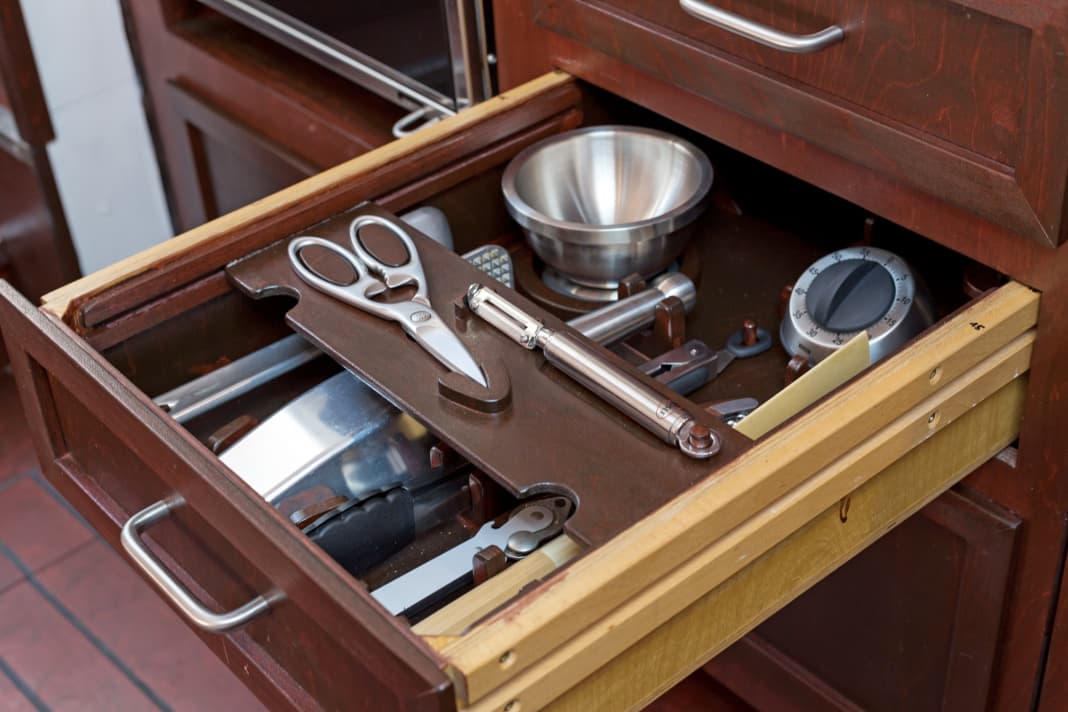





In this article:
The wind picks up, the helmsman thinks aloud about the first reef, and then a gust pushes the ship hard on the forecastle. There is an ominous crashing and rattling from the saloon and thoughts of the laptop, the camera or the expensive whiskey flash through the crew's minds. Of course, they also have to turn round immediately so that everything flies through the saloon again. When the head is stuck through the hatch for the first time and the extent of the devastation becomes clear, an extended curse is followed by the desire to quickly close the companionway so that it is opaque. But where has the bulkhead actually gone?
Most sailors have probably experienced this at some point. What can pass for creative disorganisation at home on land and, in the worst case, cause tension in the family, is an absolute no-go at sea. Tidiness on board not only helps to avoid chaos and breakages, but is also an elementary component of the safety of the boat and crew. The smaller the boat, the more difficult it seems to be to stow provisions, equipment and tools in such a way that everything is both seaworthy and easily accessible.
In demand: clever detailed solutions for cupboards and back boxes
It starts with the Nutella jar, which may turn into a splintering chocolate bomb in rough seas, and ends with the battery flex, which can be used to cut the rig in an emergency and should be accessible at all times. Here it is important to find intelligent solutions to optimise the use of every storage option. But even on large production yachts, which offer an infinite amount of storage space due to their voluminous hulls, there is sometimes a lack of detailed solutions, for example to be able to utilise forecastle boxes and lockers efficiently.
Tidying up starts with sorting out things that are either outdated, have turned out to be useless or are not needed on the planned trip. For example, there is no reason not to leave the SUP board on land if nobody wants to use it. But you can also leave superfluous crockery, duplicate writing utensils or old lines ashore. And if you haven't unpacked the genoa for the last two years because the self-tacking jib is much easier to handle, then you might not need it on the current trip either. It's also worth looking in the depths of the forecastle boxes for superfluous or simply forgotten equipment. Rusty tools, the shackle collection from the old ship, mast stays or deposit boxes not only take up space, but are also unused ballast that can even impair the seaworthiness of the ship.
A structured stowage plan is a basic requirement for good seamanship" (Leon Schulz)
Once the boat has been cleared out, it is advisable to clear out all useful items once and then stow them away again systematically. Lockable plastic boxes are ideal for sorting, protecting from moisture and safely storing not only food but also all kinds of odds and ends. Sailing professionals such as RYA instructor Leon Schulz and heavy weather trainer Constantin Claviez swear by a meticulously prepared stowage plan that is shrink-wrapped and accessible to the entire crew. This way, everyone knows where to find the ingredients for the next meal, as well as the spare shackle or spare parts for the winches. And especially when the weather changes and every move has to be right, the crew can then work quickly and in a professional manner.
Nothing must slide in heavy weather
The design of offshore racers means that there is a lack of lockers and lockers. Almost everything is stuffed into sacks and bags, which are then wedged or pressed into gaps. The stowage bags are also often stored upwind to improve performance. However, some of the tricks used by regatta professionals can also be applied to cruising boats. Offshore professional Tim Kröger recommends using the ISAF Safety Rules as a general framework for every seaworthy yacht. If heavy weather is forecast, all heavy equipment should be lashed to the centre of the boat. As cruising boats often lack fixed points, the usually very stable saloon table can be used to lash down bags or loose anchor gear.
Each crew member has a hook on which their oilskins and lifejacket hang" (Tim Kröger)
For Tim Kröger, tidiness and the discipline of the entire crew to maintain it throughout the journey are also part of the compulsory programme, as an emergency situation can arise at sea at any time. His tip: "Attach a hook to the grab rail on the saloon ceiling for each crew member to hang their oilskins and lifejackets on. If this rail is missing, you can improvise with an old sail batten. This system ensures that the crew can change quickly at any time without having to rummage through bags and cupboards."
A systematic stowage plan helps
But it is also important to keep things tidy on deck and to lash down heavy objects carefully. The dinghy and life raft should always be well secured, as should the anchor gear on the bow. RYA instructor Leon Schulz also recommends that the hatch to the anchor locker should be lockable so that it cannot open in heavy seas and on an angle and, in the worst case, the entire anchor chain falls out of the bow. Such accidents have indeed happened, and not only on the high seas, but also near the coast as a result of a sun shot.
Leon Schulz's systematic stowage plan also includes special areas such as the on-board pharmacy or the grab bag for the life raft. The expiry dates of every battery and every medication are also entered here so that they can be easily replaced at the start of the season. The same principle can of course be used to document provisions and use them up accordingly. Leon Schulz's tip for the food to be cooled: "Sliding baskets and vacuum boxes that can be vacuumed with a small hand pump and stacked for better longevity work well in the fridge. After all, you don't want everything to get mixed up in the fridge just because the ship is moving!"
Safe stowage begins in winter storage
If the cupboard starts to rattle despite all the tidiness, cushions, toilet rolls and towels prove to be extremely helpful in keeping the ship calm. If the stowage height allows, a few wine bottles can also be stowed upside down, which then clamp the upright bottles like wedges. Constantin Claviez, who regularly organises heavy weather training on the North Sea, relies on waterproof pack sacks that can be adjusted in volume to the needs of each crew member to protect textiles from moisture. These can be used as gap fillers to prevent items from slipping in lockers. On his training ship, the "Charisma", Claviez has also modified the sliding doors made of safety glass to secure the crockery and the drawers so that they cannot burst open even in heavy seas.
The case with the battery flex to cut the rig in an emergency is always ready to hand" (Constantin Claviez)
In addition, there are storage compartments designed exclusively for spare parts and tools, such as the case with the battery flex, in case the standing crop needs to be cut through in an emergency. The holders for the tool cases have been customised and secured and are easily accessible. "For us, the topic of seaworthy stowage begins in winter storage, when we review our experiences and rethink the logical categorisation on the yacht."
Cockpit and deck
Pods and traps
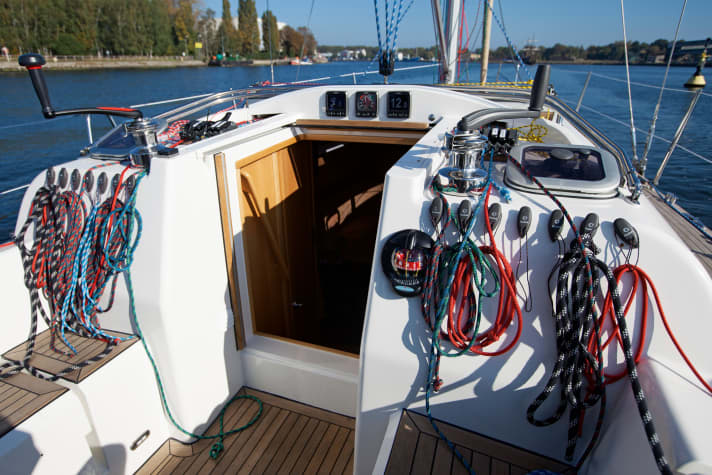
A tidy workplace not only creates order, but also safety. Sheets and halyards flying all over the cockpit pose a risk of slipping and tripping. In addition, tangled lines are programmed and quickly end up in the water or in the propeller. Mooring lines can be stowed away easily and dried better with rope holders. Another solution is pockets that can also be used to secure gloves, for example. For gennaker sheets or reefing lines, the railing is a good place to hang them up in an upright position
Dinghy, tender and co.
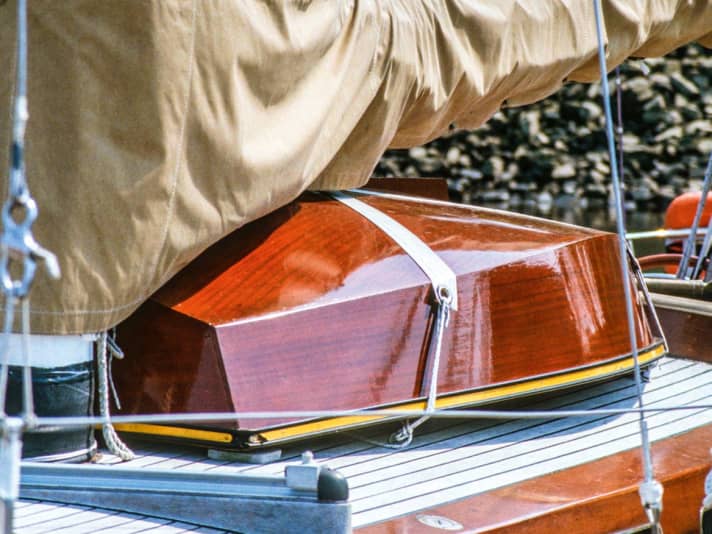
Heavy equipment such as a dinghy or life raft must always be well secured. The tender is either lashed keel-up on the deck in front of the mast or moored at the stern. Lashing straps are a tried-and-tested aid for securing heavy items in a storm-proof manner. Davits are the most elegant solution, as they do not obstruct the view or the bathing ladder. But remember the bilge plug, otherwise it will fill up
Tool
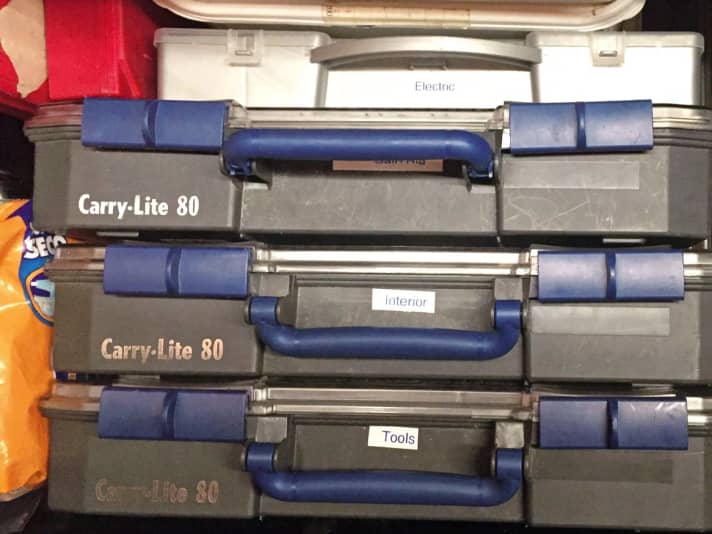
If the toolbox and spare parts store are stowed next to each other instead of stacked on top of each other, each box can be accessed individually. With additional waterproof labelling, finding the required on-board equipment is child's play for every crew member. Of course, this stowage principle also works well under the saloon bench or double berth
Fender
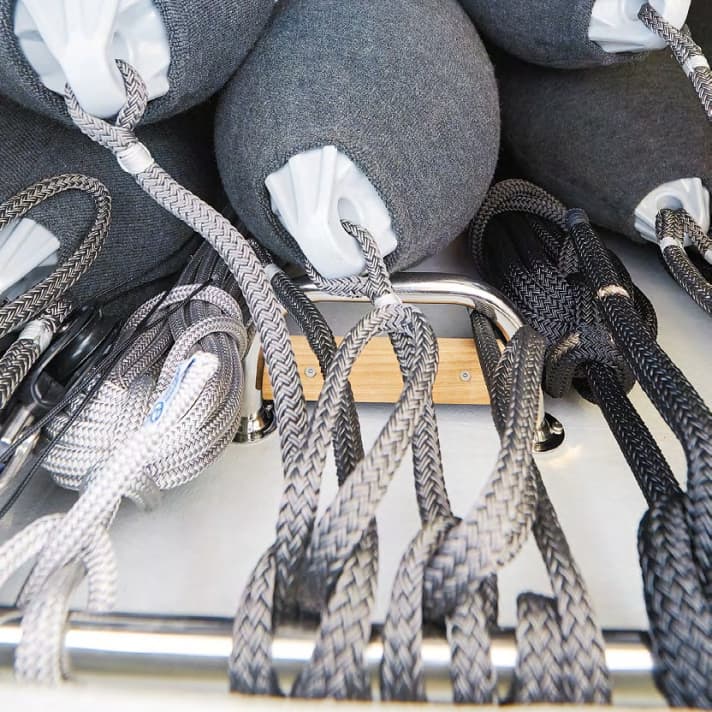
Fenders that are carelessly thrown into the saloon are a nuisance for the crew below deck, as they are not only bulky but also present a tripping hazard. In the often deep forecastle boxes or the sail load, they are quickly out of reach and can only be reached with headfirst or climbing manoeuvres. The same applies to mooring lines. Simple line holders are ideal for keeping ropes and fender lines within easy reach at all times and not obstructing access to the rest of the stowage equipment
Baking box
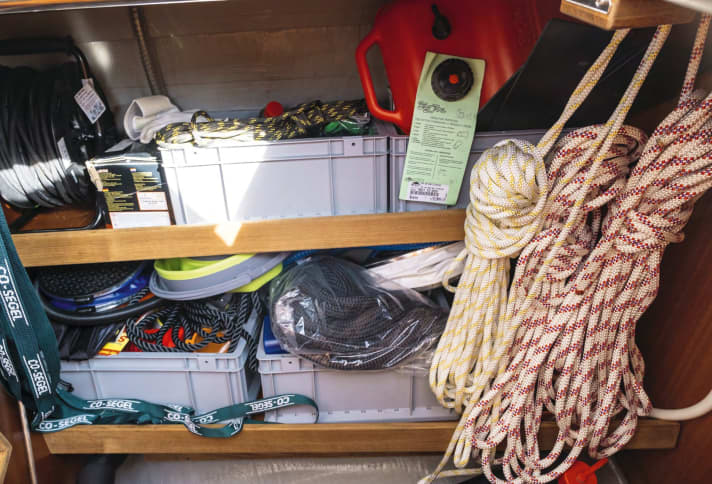
Storage boxes offer plenty of space for all kinds of equipment. Without a basic organisation system, it is often difficult to find what you are looking for. Dividers and plastic boxes, which can be divided up according to the principle of organising boxes, offer a remedy. Items can also be hung up in bags or nets.
Plug-in bulkhead
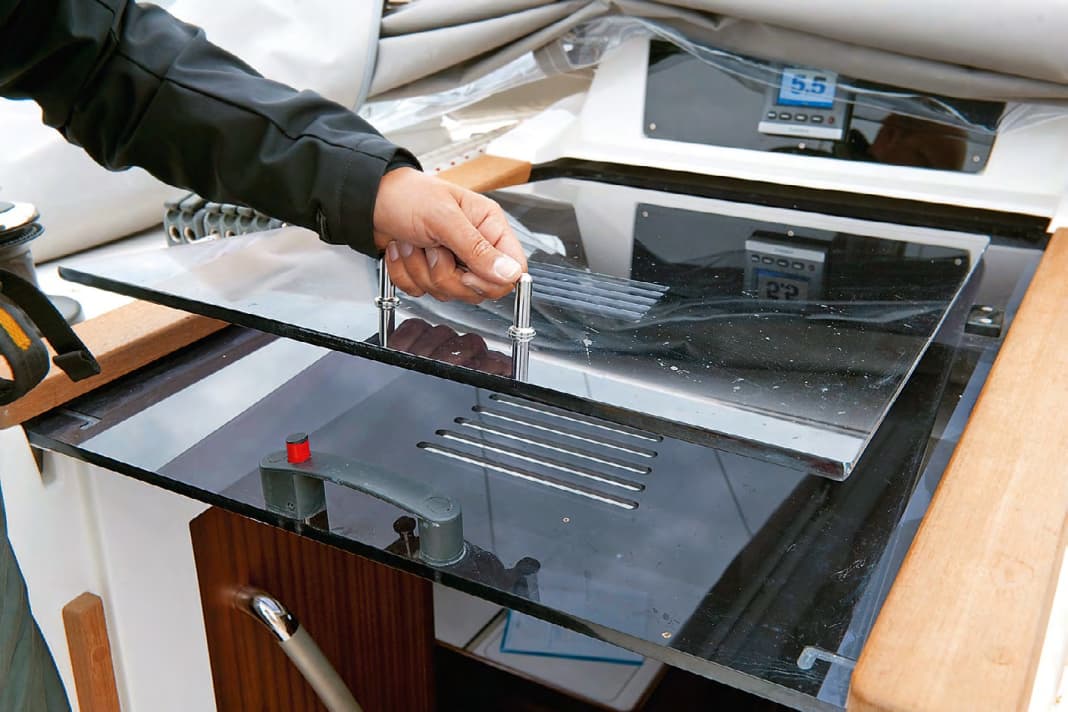


Only a few shipyards provide a fixed storage location for bulkheads. However, a flying bulkhead can cause nasty damage to the ship and crew. To protect the companionway from rain and overflowing water, it should nevertheless always be within easy reach. A neat solution is a bracket that is screwed to a bulkhead in the forecastle from the inside
Salon and berths
Articles of daily use
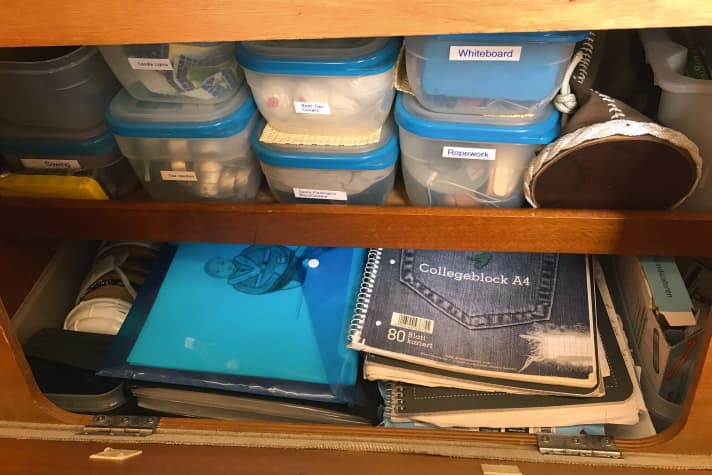
Admittedly, at first glance, the many plastic tins may not exactly conjure up an image of seafaring romance. But when it comes to structured stowage on board, there is nothing better. They are light, waterproof and last an eternity. They are also easy to store seaworthy
Batteries
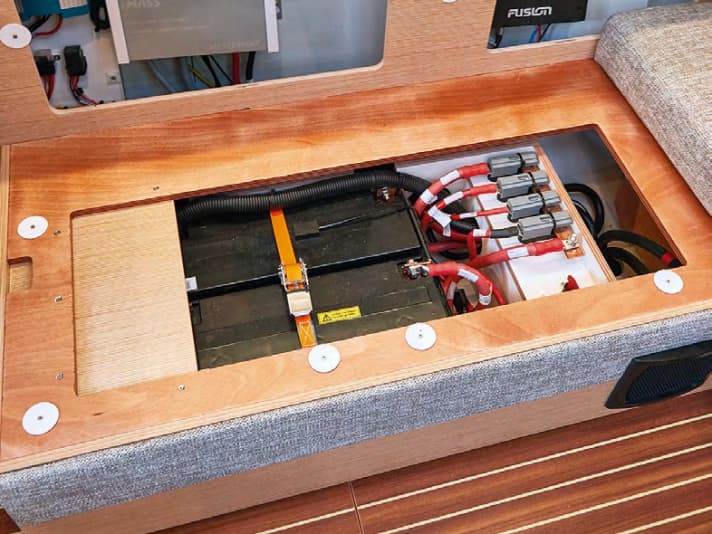
The batteries can turn into very dangerous projectiles when the boat is in motion. Even if their weight makes them appear fixed and therefore safe, they should always be secured with a lashing strap. Once the batteries start moving, Holland is in trouble!
Sailing knife
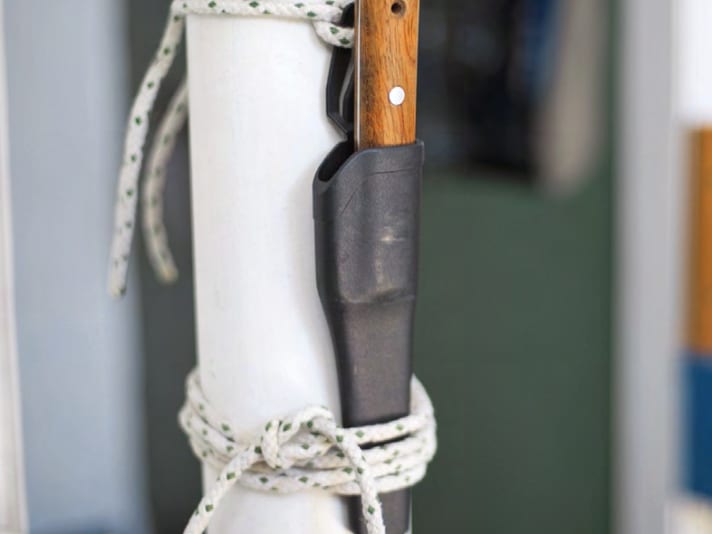
A good sailor's knife is a sailor's friend. It is not uncommon to have a whole collection on board. And yet it happens again and again that it is not to hand at the moment it is needed. So why not place a knife strategically so that it is always visible and within easy reach?
Fruit and vegetables
![Fruit and vegetables inside of a net hanging from the ceiling of a saloon of a sailing ship which is prepared for the ARC (Atlantic Rally Cruise) leading from Las Palmas, Gran Canaria, Canary Islands, Spain to St.Lucia, Caribbean. ESP, 1999 | Fruit and vegetables inside of a net hanging from the ceiling of a saloon of a sailing ship which is prepared for the ARC (Atlantic Raly Cruise) leading from Las, Palmas, Gran Canaria, Canary Islands, Spain to St.Lucia, Caribbean. ESP, 1999 | [(c) Nicolai Krauss, Eichholz 21, 20459 H a m b u r g; Tel. +49-40-41919050; www.nico-krauss.de; E-Mail: mail@nico-krauss.de; Account: H a m b u r g e r S p a r k a s s e; Account no. 1237 473382; Sort code: 20050550; IBAN: DE 15 2005 0550 1237 4733 82 BIC HASPDE HH; Tax office Hamburg-Neustadt-St.Pauli; Tax number: 25/308/56235; www.freelens.com/clearing; Any use only against payment and receipt; if the photo is used for purposes other than journalism, please contact the photographer. No model release]. [#0,26,121#]](https://media.delius-klasing.de/dk-wassersport/images/dpr_auto,fl_progressive,f_auto,c_fill,g_face:auto,h_459,w_712/q_auto:eco/yacht/StauenSicherheitSeemannschaft2022NKr_ESP_1390_00049_006_d692de0a109790c71de06931e382f8ec/fruit-and-vegetables-inside-of-a-net-hanging-from-the-ceiling-of-a-saloon-of-a-sailing-ship-which-is-prepared-for-the-arc-atlantic-rally-cruise-leading-from-las-palmas-gran-canaria-canary-islands-spain-to-st-lucia-caribbean-esp-1999-fruit-and-vegetables-inside-of-a-net-hanging-from-the-ceiling-of-a-saloon-of-a-sailing-ship-which-is-prepared-for-the-arc-atlantic-raly-cruise-leading-from-las-palmas-gran-canaria-canary-islands-spain-to-st-lucia-caribbean-esp-1999-c-nicolai-krauss-eichholz-21-20459-h-a-m-b-u-r-g-tel-49-40-41919050-www-nico-krauss-de-e-mail-mail-nico-krauss-de-account-h-a-m-b-u-r-g-e-r-s-p-a-r-k-a-s-s-e-account-no-1237-473382-sort-code-20050550-iban-de-15-2005-0550-1237-4733-82-bic-haspde-hh-tax-office-hamburg-neustadt-st-pauli-tax-number-25-308-56235-www-freelens-com-clearing-any-use-only-against-payment-and-receipt-if-the-photo-is-used-for-purposes-other-than-journalism-please-contact-the-photographer-no-model-release-0-26-121-)
For long trips with a hungry crew, the stowage space for food can be extended with tensioned hanging nets without major conversion work. Another advantage of suspended storage: you can watch your supplies dwindle and refuel in good time
Rig a leeward sail
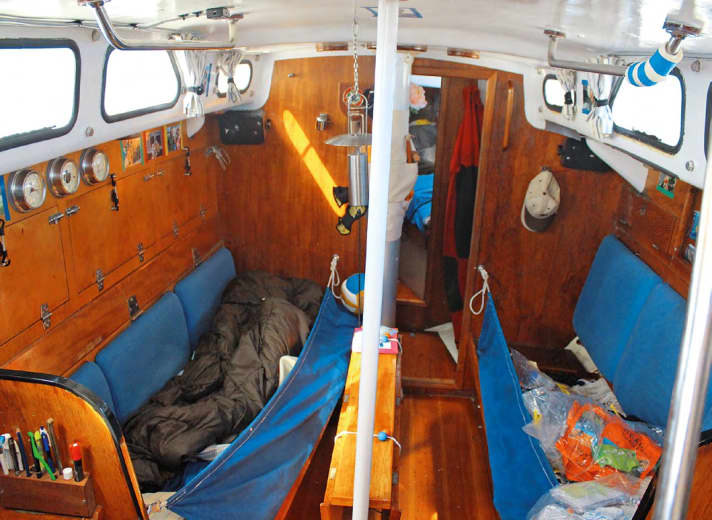
If there is a lack of storage space, not only tired crew members can sleep safely on the saloon benches with the help of leeches. Sea bags, cushions or the photo bag also find a seaworthy and easily accessible place when the boat is heeled over
Bathroom/wet room
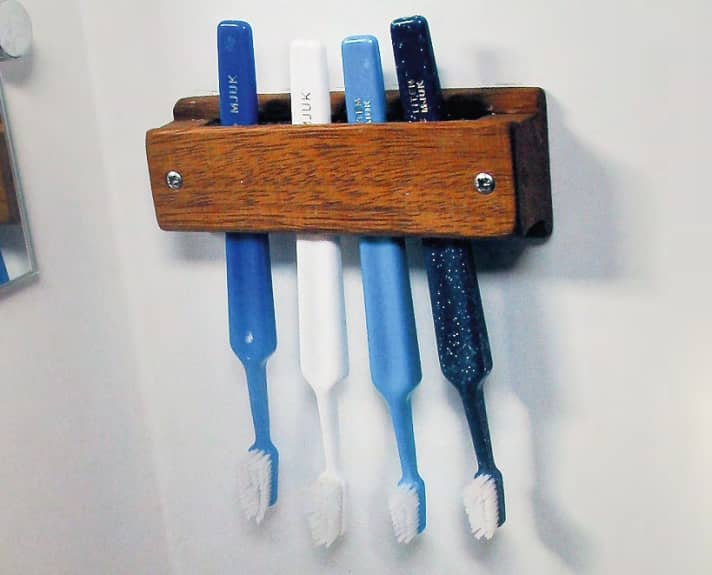
Nothing is more disgusting than when the toothbrush ends up behind the toilet or even in it. If you take the time to install a customised holder for the small brushes, you will always have a good and, above all, clean smile
On-board pharmacy
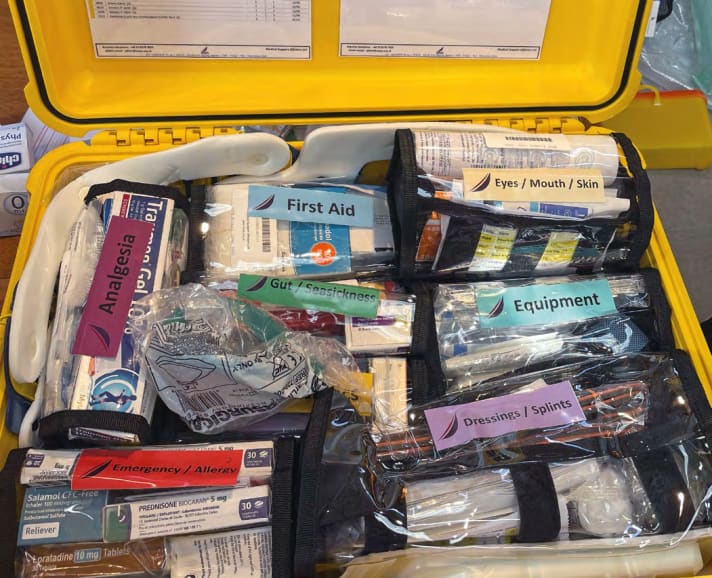
A well organised and documented on-board pharmacy proves to be a blessing in an emergency. Transparent plastic bags, in which the medication is categorised according to its intended use, ensure even more order and quicker access
Perfect pantry
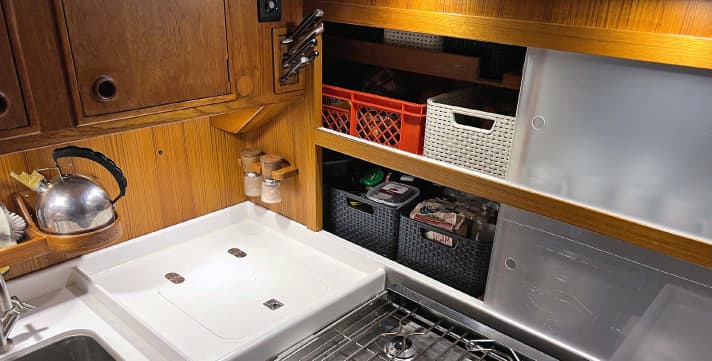
A prime example of a seaworthy galley that will impress even the in-laws: The cooker is gimballed, while the kettle, spices and sharp knives are secured individually and separately from the worktop. Durable food is stored in non-slip boxes, which are also protected by sliding safety glass doors. If only it weren't for the washing up!
Pot lid
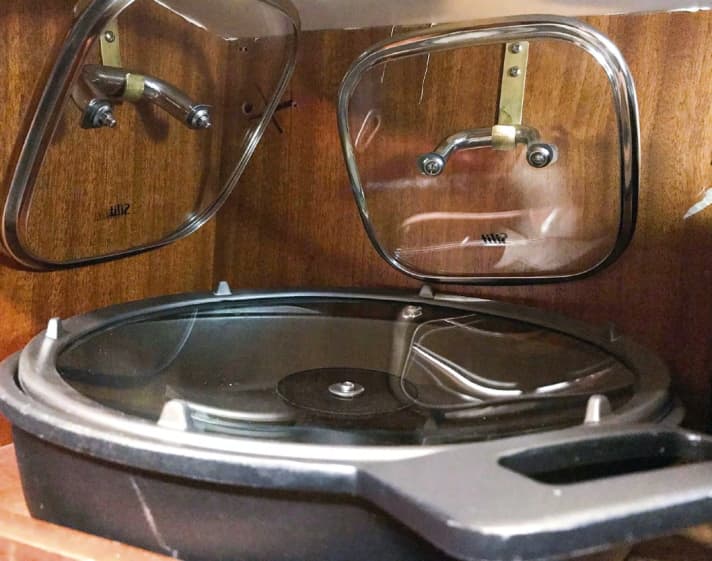
Pot lids not only rattle as if they had a life of their own, they also tend to creep into the furthest corners of the cupboards in the pantry, which can only be reached with gripping aids anyway. Simple lid holders on the inside of the door or on the wall bring peace and order to the cupboard
Inventories
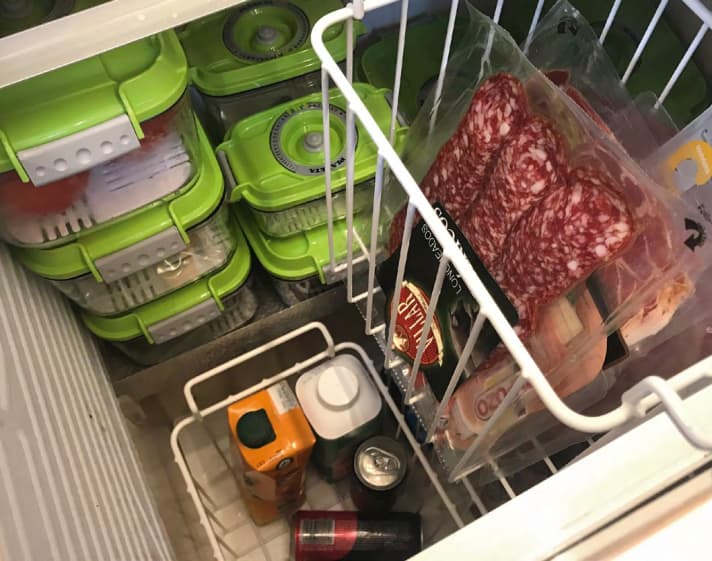
Baskets and easily stackable plastic boxes are used to ensure that the chilled treats don't tumble around wildly in rough seas. With vacuum units, the air can also be sucked out with a small hand pump, which can significantly increase the longevity of the food
Tableware
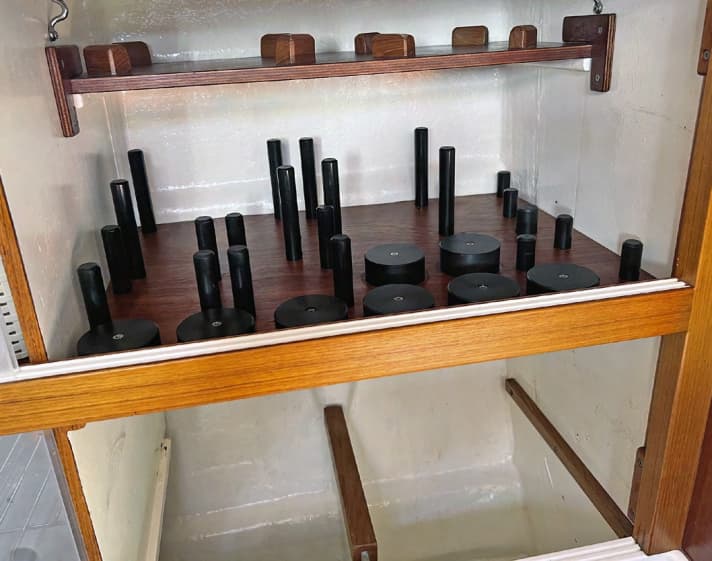
This storage system, which is also protected by a sliding safety glass door, can be customised precisely to the owner's needs. Crockery, bowls, cooking pots and glasses are perfectly held in place by small wooden bars and blocks as well as a rail system
Further tips
- Take inventory:At the beginning of the season, remove everything from the boat that has expired, is no longer needed or can be better stored ashore
- Create a stowage plan:If you simply put everything away as you have space, you will quickly lose track. If all items of equipment and provisions are carefully recorded in the stowage plan, everything can be found again at any time. In addition, note the expiry and use-by dates of batteries, medicines and food to stay on top of the supply situation
- Protect cables:It is best to route cables and hoses running through the storage space away from the danger zone. If this is not possible, they should be protected with wooden covers or pipes
- Use dunnage:Plastic boxes in all sizes help with sorting, organising and storing. They are also waterproof and can be labelled easily
- Heavy control:The less the stowed goods can move, the better, especially heavier objects must be lashed down. If they start to move in rough seas or even shoot through the hold, they become a risk of injury and can easily damage other parts. Also check the on-board batteries regularly and tighten the lashing straps
- Place weights:The heavier the items, the lower down they should be stored, paying attention to the longitudinal trim. The heaviest items are safest in the centre of the boat. The wide sterns of modern yachts can take a lot of load, but too much weight in the bow and stern generally worsens the sea behaviour here too
- Labelling things:If tinned food or bottles are stowed in the bilge, remove the label. Note the expiry date and contents on the tray or jar with a waterproof pen. This prevents can roulette and clogging of the bilge pump
- Avoid flax salad:Stow sheets and halyards neatly. Otherwise, the lines in the cockpit or saloon could become a risk of injury, get twisted or even end up in the propeller
- Mark lines:Coloured markings on the lines make it easy to identify the length of the mooring lines even when they are shot up
- Maintain discipline:Keeping the boat tidy is part of good seamanship, prevents problems and makes life on board more pleasant. It should be observed by the entire crew from the beginning to the end of the trip

